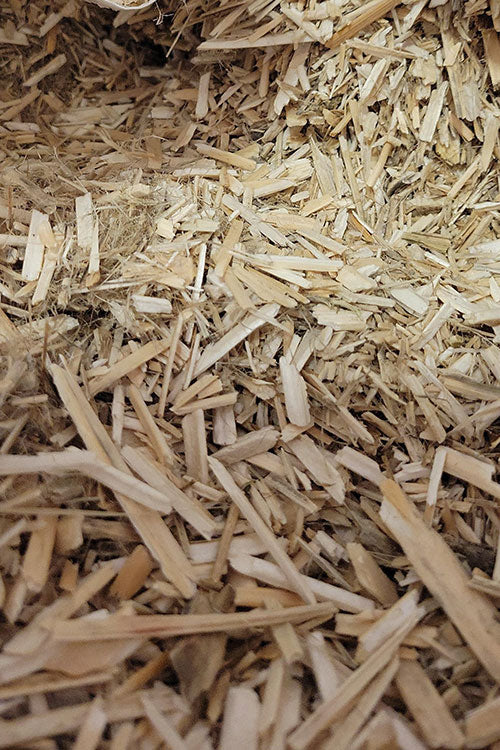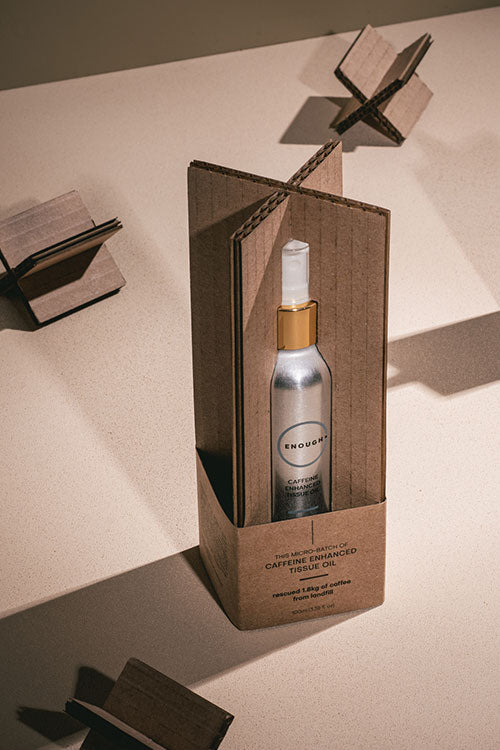Sustainable Packaging
Eco-Friendly Innovation: Our Commitment to Sustainable Packaging
At ENOUGH., our commitment to sustainability goes beyond our skincare formulas; it extends to our packaging as well. Our upcycling ethos ensures that every aspect of our product, from contents to container, is designed to minimise environmental impact and champion eco-friendly practices.
Our Hempcelium® Packaging
Developed exclusively for ENOUGH. by M2Enviro - a company providing alternatives to petroleum-based materials by harnessing the power of mycelium

Made from mycelium
The root system of mushrooms act as a natural glue to bind together materials creating a strong structure

Grown on Hemp Hurd
This woody agricultural waste from hemp production is the substrate on which the mycelium grows

Home-compostable
Lightweight and sturdy, this packaging can be broken apart and scattered on plants as nutritious food
Hempcelium® is a groundbreaking packaging solution consisting of hemp agricultural waste with mushroom mycelium to create a sustainable and high performing alternative to other packaging materials such as polystyrene.
Mycelium is the vegetative part of a fungus, consisting of a network of fine white filaments called hyphae. It serves as the root-like structure of mushrooms and is the primary mode of nutrient transportation and absorption for the fungus. Mycelium plays a crucial role in nature by decomposing organic matter, breaking down complex compounds into simpler forms that can be absorbed by the fungus. Additionally, it acts as a natural adhesive, binding together organic materials to form a strong and resilient network. Recently, mycelium has gained attention for its potential applications in various industries, including packaging, construction, and biotechnology, as a sustainable and eco-friendly alternative to traditional materials.
Our packaging products aren’t manufactured; they’re grown. The process begins by inoculating the hemp hurd substrate with mycelium, the vegetative root structure of mushrooms. Over time, the mycelium grows and binds with the hemp hurd, forming a dense and durable material. Once the hemp substrate is completely colonised, it is broken up and packed into moulds. In controlled conditions, the mycelium continues to colonise the hemp substrate, taking the shape of the mould. Once fully grown, the material is removed from the mould, resulting in Hempcelium®. This sustainable, biodegradable material is eco-friendly and significantly better for the planet.
Hemp hurd is the inner woody core of the hemp plant, surrounded by the outer hemp fiber or bast fiber, which is commonly used for hemp-based materials and textiles. While the bast fiber has numerous applications, the hurd generally has more limited uses. After the bast fiber is removed, the hemp hurd is processed into smaller 2-3 mm wood chips for use in our packaging. Our hemp hurd is sourced from local South African farmers, supporting sustainable and eco-friendly practices.
We choose hemp as a substrate for several reasons. Firstly, using locally grown hemp in South Africa minimizes our carbon footprint by reducing transportation distances. Studies have shown that hemp performs exceptionally well compared to other agricultural waste products, making it an ideal choice for waste valorization. This means we find valuable uses for a byproduct that would otherwise go unused.
Our commitment to sustainability is central to everything we do, and using hemp aligns perfectly with that mission. Hemp is excellent at carbon sequestration, capturing carbon dioxide from the atmosphere. By using hemp in our products, we create a sustainable material and contribute to lowering our overall carbon footprint.
Specifically, we use the inner woody core of the hemp plant, known as hemp hurd, which typically has limited applications. By utilizing these parts of the plant, we maximize the value of the hemp crop and minimize waste, supporting our goal of reducing environmental impact and promoting eco-friendly practices.
While we haven’t yet tested Hempcelium’s shelf life, studies have shown that mycelium composite materials can have a shelf life of up to 30 years.
To dispose of your Hempcelium® packaging, simply break it apart and scatter it into your garden. This biodegradable material serves as nutritious food for your plants, enriching the soil as it decomposes. Hempcelium is designed to be fully home compostable, ensuring that it returns to nature without harming the environment. By breaking it down and integrating it into your garden, you contribute to a sustainable cycle that benefits both your plants and the planet. This eco-friendly disposal method aligns with our commitment to sustainability and waste reduction.
Our Upcycled Board Packaging

Packaging Waste
We collect and use packaging waste for our products

Laser Cut Board
Our designs are laser cut from this packaging waste

A Work of Art
Our final packaged products in their outer boxes

